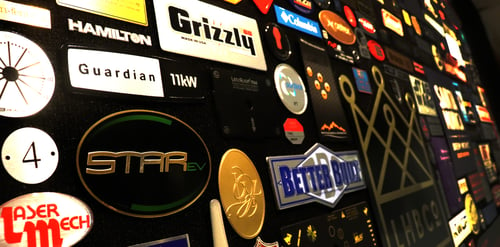When looking for a nameplate for your product, one of the natural questions is how much it is going to cost. Tooling cost often needs clarification. It helps to understand why tooling is needed and have appropriate discussions to set cost expectations. This post answers some of the questions related to the affordability of tooling for nameplates.
Why is Tooling Necessary for Nameplates?
Every project starts out as flat sheets of material decorated based on customer artwork in a repeated manner across the sheet. The nameplate gets cut out or stamped using blank dies which are built to the desired size and shape. Custom tools are needed to efficiently produce in mass production.
Is Tooling a Recurring Cost?
Tooling is typically established as a non-recurring cost on the first purchase order. New tooling is not required unless there is a change in part dimensions. Tooling costs are generally included in the setup fees shown on your quote.
Affordable Nameplate Tooling Options
McLoone works with our customers to understand the individual application for each project that comes in. We are always looking for the most affordable and economical solution. An in-house tool shop keeps costs and build times at a minimum. Each project is unique and reviewed based on the material, volume, and end application requirements. Options including die cut and hard tooling are evaluated.
Low cost tooling for metal nameplates is a popular choice in industries including industrial applications and consumer goods. All tooling is custom built to your requirements. Common shapes like rectangles and circles are possible. Unique shapes and cutouts to allow for buttons, screws, and knobs are also available. Embossing can be added for dimension and to add to durability or aesthetics. Keep these considerations in mind if you are interested in keeping your tool costs down for your next metal nameplate project:
- Avoid sharp corners or tight angles. Basic shapes with minimal cutouts are ideal.
- Parts can be cut to the liner.
- Materials need to be less than .032" thick, including adhesive. Metal and plastic options are available in a variety of finishes.
- Allow for part tolerance of +/- .015" in dimensions and for any cutouts.
- Nameplates edges may show a burr.
We will help identify a cost-effective solution to produce quality nameplates and labels no matter if it is using one of the thousands of existing blank dies in our library or creating a custom build for your unique application.
Related Posts
5 Ways Embossed Aluminum Makes an Impact for Nameplates
Basic Tool Information for Metal Nameplates and Badges
3 Ways to Dress Up Metal Nameplates to Increase Brand Awareness
Where and When Embossing on Plastic Material Makes Sense




